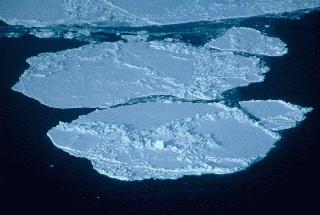Movie of Yearly Changes in Sea Ice around the North Pole
|
This movie shows how the sea ice around the North Pole changes from season to season throughout the year. During the winter the cold temperatures freeze more and more of the water in the Arctic Ocean. The sea ice pack gets bigger and bigger. When is there the most sea ice? There is usually a lot of sea ice in early spring, right after winter ends, around March.
In late spring the weather gets warmer. The sea ice starts to melt. All through the summer more and more of the ice melts. When is there the least sea ice? Since a lot of ice melts in the summer, there is usually much less sea ice in early fall around September, right after the end of summer.
The freezing and melting of the sea ice happens year after year. It is one of the cycles that come with the changing seasons.
This movie shows seven years of this cycle, from January 2002 through December 2008.
(Note: If you cannot see the movie you may need to download the latest QuickTime player.)
|
If you want to see more movies and pictures of sea ice, go to the NSIDC web site to:
You might also be interested in:

Sea ice is frozen seawater. It can be several meters thick and it moves over time. Although the salts in the seawater do not freeze, pockets of concentrated salty water become trapped in the sea ice when
...more
Let's get rid of some common misconceptions about the seasons. The Earth's orbit is in the shape of an ellipse, so that sometimes the Earth is a little bit closer to the Sun than at other times. Is this
...more
There are two oceans in Earth's polar regions. The Arctic Ocean is in the north polar region. The Southern Ocean is in the south polar region. The oceans that are in the polar regions are a bit different
...more
Windows to the Universe and other educational programs of the University Corporation for Atmospheric Research Office of Education and Outreach invite you to explore Earth's polar regions with your students
...more
Dive into one of our new polar activities or games! Animation showing Annual Variation of Sea Ice Extent in the Arctic Animation showing Annual Variation of Sea Ice Extent in the Antarctic Changing Planet:
...more
Many educators are now finding opportunities to teach about Earth's climate and climate change in their classrooms. Windows to the Universe provides an interlinked learning ecosystem to a wealth of resources
...more
Altocumulus clouds are part of the Middle Cloud group (2000-7000m up). They are grayish-white with one part of the cloud darker than the other. Altocumulus clouds usually form in groups and are about
...more













